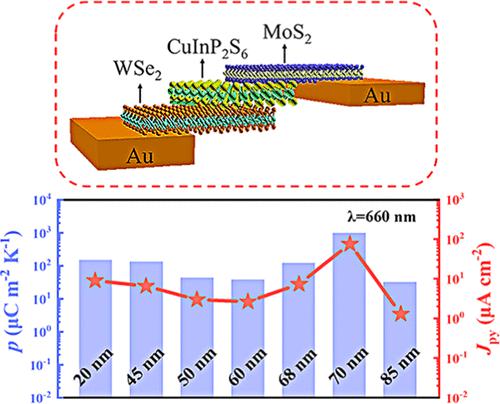当前位置:
X-MOL 学术
›
ACS Appl. Mater. Interfaces
›
论文详情
Our official English website, www.x-mol.net, welcomes your
feedback! (Note: you will need to create a separate account there.)
Ferroelectricity-Driven Self-Powered Weak Temperature and Broadband Light Detection in MoS2/CuInP2S6/WSe2 van der Waals Heterojunction Nanoarchitectonics
ACS Applied Materials & Interfaces ( IF 8.3 ) Pub Date : 2023-12-15 , DOI: 10.1021/acsami.3c12695
Dan Qiu 1 , Pengfei Hou 1
ACS Applied Materials & Interfaces ( IF 8.3 ) Pub Date : 2023-12-15 , DOI: 10.1021/acsami.3c12695
Dan Qiu 1 , Pengfei Hou 1
Affiliation

|
Two-dimensional ferroelectric materials enrich the modulation degrees of freedom in self-powered van der Waals temperature/light detectors by incorporating pyroelectric and bulk photovoltaic effects. However, in addition to the low polarization, the practical applications of these materials are limited due to the significant challenge posed by their ultrathin nature, which affects their polarization stability. In this report, we introduce a design for a dual heterostructure-stabilized van der Waals heterojunction that addresses this challenge by improving the performance and extending the operational lifetime of self-powered van der Waals temperature/light detectors. The design is demonstrated using the MoS2/CuInP2S6 (CIPS)/WSe2 van der Waals heterojunction, which exhibits sensitivity to small temperature changes induced by weak light across the ultraviolet to mid-infrared spectrum. It can generate a noticeable pyroelectric current without the need for an external voltage, and its pyroelectric coefficient exceeds 130 and 978 μC/m2 K for 45 and 70 nm CIPS, respectively. The heterojunction offers high detection accuracy, with a temperature variation sensitivity as small as 0.1 K and an optical power intensity detection range from low to 1 μW/cm2. Additionally, the heterojunction exhibits exceptional detectivity (D*) for different light wavelengths. Remarkably, the self-powered detection performance remains stable for months without obvious degradation in the natural environment. These results offer a promising solution for high-performance, self-sustaining temperature/light detection applications and pave the way for the development of future ferroelectricity-driven photodetection technologies.
中文翻译:

MoS2/CuInP2S6/WSe2 范德华异质结纳米结构中铁电驱动的自供电弱温度和宽带光检测
二维铁电材料通过结合热释电和体光伏效应,丰富了自供电范德华温度/光探测器的调制自由度。然而,除了低偏振之外,这些材料的实际应用还受到其超薄特性带来的重大挑战的限制,这影响了它们的偏振稳定性。在本报告中,我们介绍了一种双异质结构稳定范德华异质结的设计,该设计通过提高自供电范德华温度/光探测器的性能并延长其使用寿命来应对这一挑战。该设计使用MoS 2 /CuInP 2 S 6 (CIPS)/WSe 2范德华异质结进行了演示,该异质结对紫外至中红外光谱范围内的弱光引起的微小温度变化表现出敏感性。它无需外部电压即可产生明显的热释电电流,对于45和70 nm CIPS,其热释电系数分别超过130和978 μC/m 2 K。异质结检测精度高,温度变化灵敏度小至0.1 K,光功率强度检测范围低至1 μW/cm 2 。此外,异质结对不同的光波长表现出出色的探测率( D *)。值得注意的是,自供电检测性能在自然环境中保持数月稳定,没有明显下降。 这些结果为高性能、自维持温度/光检测应用提供了一种有前途的解决方案,并为未来铁电驱动光电检测技术的发展铺平了道路。
更新日期:2023-12-15
中文翻译:

MoS2/CuInP2S6/WSe2 范德华异质结纳米结构中铁电驱动的自供电弱温度和宽带光检测
二维铁电材料通过结合热释电和体光伏效应,丰富了自供电范德华温度/光探测器的调制自由度。然而,除了低偏振之外,这些材料的实际应用还受到其超薄特性带来的重大挑战的限制,这影响了它们的偏振稳定性。在本报告中,我们介绍了一种双异质结构稳定范德华异质结的设计,该设计通过提高自供电范德华温度/光探测器的性能并延长其使用寿命来应对这一挑战。该设计使用MoS 2 /CuInP 2 S 6 (CIPS)/WSe 2范德华异质结进行了演示,该异质结对紫外至中红外光谱范围内的弱光引起的微小温度变化表现出敏感性。它无需外部电压即可产生明显的热释电电流,对于45和70 nm CIPS,其热释电系数分别超过130和978 μC/m 2 K。异质结检测精度高,温度变化灵敏度小至0.1 K,光功率强度检测范围低至1 μW/cm 2 。此外,异质结对不同的光波长表现出出色的探测率( D *)。值得注意的是,自供电检测性能在自然环境中保持数月稳定,没有明显下降。 这些结果为高性能、自维持温度/光检测应用提供了一种有前途的解决方案,并为未来铁电驱动光电检测技术的发展铺平了道路。

































 京公网安备 11010802027423号
京公网安备 11010802027423号